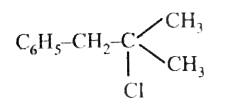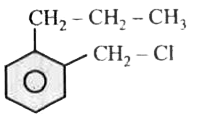Two isomers of formula C4H9Br are Aand B, A on reaction with alcoholic KOH gives of molecular formula C4H8 by E1 reaction. B on reaction with alcoholic KOH gives D and E as products by Saytzeff's rule. Identify A, B, C, D, E.
(i) C4H9Br: Two isomers may be there : (A)CH3−CH3∣C∣Br−CH3 Text butyl bromide and CH5−C∣BrH−CH−2−CH3α-Bromobutane
(ii) A on reaction with alcoholic KOH gives iso butylene C as the product.

(iii) 2-bromobutane B on reactiön with alcoholic KOH follows Saytzeff.s rule to give a mixture of olefins in different amounts.


Topper's Solved these Questions
- HALOALKANES AND HALOARENESBook:FULL MARKSChapter:HALOALKANES AND HALOARENESExercise:Additional Questions Solved (3-Marks Questions)
Explore 32 Videos
- FUNDAMENTALS OF ORGANIC CHEMISTRY Book:FULL MARKSChapter:FUNDAMENTALS OF ORGANIC CHEMISTRY Exercise:Additional Questions Solved (5-Marks Questions)
Explore 15 Videos
- HYDROCARBONSBook:FULL MARKSChapter:HYDROCARBONSExercise:Additional Question Solved (5 mark question )
Explore 15 Videos
Similar Questions
Two isomers A and B having molecular formula C3H8O when passed separately over heated alumina produce compound C with molecular formula C3H6. C on ozonolysis produces D and E. Between them, D undergoes iodoform reaction but not E. Identify A, B, C, D and E. Write the equations of the reactions concerned.
View SolutionTwo isomers A and B having molecular formula C3H8O when passed separately over heated alumina produce compound C with molecular formula C3H6. C on ozonolysis produces D and E. Between them, D undergoes iodoform reaction but not E. Identify A, B, C, D and E. Write the equations of the reactions concerned.
View Solution
Knowledge Check
A compound A with molecular formula C H Cl gives a white precipitate on adding silver nitrate solution. A on reacting with alcoholic KOH gives compound B as the main product. B on ozonolysis gives C and D.C gives Cannizaro reaction but not aldol condensation. D gives aldol condensation but not Cannizaro reaction. A is :
AC6H5−CH2−CH2−CH2−CH2−ClBC6H5−CH2−CH2−C∣ClH−CH3C D
D
Two isomers A and B having molecular formula C3H8O when passed separately over heated alumina produce compound C with molecular formula C3H6. C on ozonolysis produces D and E. Between them, D undergoes iodoform reaction but not E. Identify A, B, C, D and E. Write the equations of the reactions concerned.
View SolutionAn organic compound (A) on treatment with ethyl alcohol gives a carboxylic acid (B) and compound (C). The hydrolysis of (C) under acidic conditions gives (B) and (D). Oxidation of (D) with KMnO4 also gives (B). (B) on heating with Ca(OH)2 gives (E) (molecular formula, C3H6O). (E) does not give Tollens test and does not reduce Fehling's solution but forms a 2,4−dinitrophenyl hydrazone. Identify (A),(B),(C),(D), and (E).
View SolutionAn organic compound (A) on treatment with ethyl alcohol gives a carboxylic acid (B) and compound (C). The hydrolysis of (C) under acidic conditions gives (B) and (D). Oxidation of (D) with KMnO4 also gives (B). (B) on heating with Ca(OH)2 gives (E) (molecular formula, C3H6O). (E) does not give Tollens test and does not reduce Fehling's solution but forms a 2,4−dinitrophenyl hydrazone. Identify (A),(B),(C),(D), and (E).
View SolutionAn organic compound (A) on treatment with ethyl alcohol gives a carboxylic acid (B) and compound (C). The hydrolysis of (C) under acidic conditions gives (B) and (D). Oxidation of (D) with KMnO4 also gives (B). (B) on heating with Ca(OH)2 gives (E) (molecular formula, C3H6O). (E) does not give Tollens test and does not reduce Fehling's solution but forms a 2,4−dinitrophenyl hydrazone. Identify (A),(B),(C),(D), and (E).
View SolutionAn organic compound (A) on treatment with ethyl alcohol gives a carboxylic acid (B) and compound (C). The hydrolysis of (C) under acidic conditions gives (B) and (D). Oxidation of (D) with KMnO4 also gives (B). (B) on heating with Ca(OH)2 gives (E) (molecular formula, C3H6O). (E) does not give Tollens test and does not reduce Fehling's solution but forms a 2,4−dinitrophenyl hydrazone. Identify (A),(B),(C),(D), and (E).
View SolutionAn organic compound (A) on treatment with ethyl alcohol gives a carboxylic acid (B) and compound (C). The hydrolysis of (C) under acidic conditions gives (B) and (D). Oxidation of (D) with KMnO4 also gives (B). (B) on heating with Ca(OH)2 gives (E) (molecular formula, C3H6O). (E) does not give Tollens test and does not reduce Fehling's solution but forms a 2,4−dinitrophenyl hydrazone. Identify (A),(B),(C),(D), and (E).
View SolutionAn organic compound (A) on treatment with ethyl alcohol gives a carboxylic acid (B) and compound (C). The hydrolysis of (C) under acidic conditions gives (B) and (D). Oxidation of (D) with KMnO4 also gives (B). (B) on heating with Ca(OH)2 gives (E) (molecular formula, C3H6O). (E) does not give Tollens test and does not reduce Fehling's solution but forms a 2,4−dinitrophenyl hydrazone. Identify (A),(B),(C),(D), and (E).
View Solution
